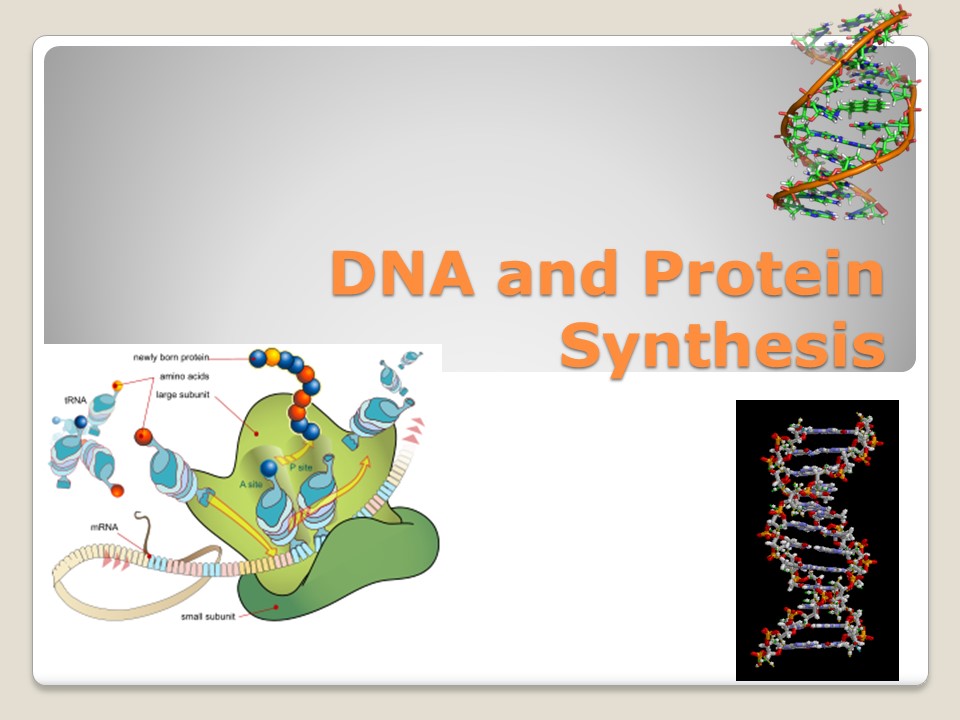DNA and Protein Synthesis - PowerPoint PPT Presentation
Title:
DNA and Protein Synthesis
Description:
DNA and Protein Synthesis DNA Does 2 Important Things in a Cell: 1)DNA is capable of replicating itself. Every time a cell divides, each DNA strand makes an exact ... – PowerPoint PPT presentation
Number of Views:395
Avg rating:3.0/5.0
Title: DNA and Protein Synthesis
1
DNA and Protein Synthesis
2
DNA Does 2 Important Things in a Cell
- 1)DNA is capable of replicating itself. Every
time a cell divides, each DNA strand makes an
exact copy of itself. - 2)DNA directs the production of proteins in the
cell. DNA contains the instructions on how to
make proteins.
3
The Importance of Proteins
- Proteins are the workhorses of the cell. They
build all of the important structures and carry
on most of the important cellular functions. - What types of proteins are made determine
everything about the organism and how it
functions.
4
Review of Protein Structure
- Proteins are large polymers made of long chains
of amino acids. - Amino Acids bind together with peptide bonds.
- A proteins final shape determines its function.
This shape is determined by its amino acid
sequence.
5
Protein Structure
- Proteins are made by ribosomes.
- Amino acids are put together in a long chain
which then folds and bends to determine the final
shape. - Remember Shape equals function!
- So, it is VERY important that the amino acid
sequence is correct!
6
What determines the correct amino acid sequence
in a protein?
- The DNA in a cell determines the sequence of
amino acids in a protein. - The DNA sequence is a code that determines which
amino acid is first, which is second, etc.
DNA determines protein
7
DNA leads from afar..
- The DNA in a cells nucleus determines the
sequence of amino acids that are put together at
the ribosome. - Yet, the DNA never leaves the nucleus!
- How does the DNA do this?
8
Chromosomes to Genes
9
Messenger RNA (mRNA)
- DNA is able to tell the ribosome how to build
the protein by sending a messenger. - This comes in the form of an RNA molecule.
- Therefore, this is called messenger RNA, or mRNA.
10
From DNA to Protein
- Protein Synthesis has 2 main processes
- 1) Transcription (to write) making a mRNA
molecule - 2) Translation (to read) making the protein,
using the mRNA as a guide. - Together, these are called Gene Expression
11
RNA A Major Player
- Three types of RNA are used in protein building
- mRNAmessenger RNA (made in nucleuscarries the
genetic code) - tRNAtransfer RNA (brings amino acids to the
ribosome) - rRNAribosomal RNA (what ribosomes are made of)
Ribonucleic Acid
12
RNA Vs. DNA
- RNA differs from DNA in 3 ways
- RNA is single-stranded DNA is double-stranded
- RNA has Ribose DNA has Deoxyribose
- RNA has Uracil DNA has Thymine
Uracil is found in RNA only
13
- RNA Vs. DNA
14
Transcription Reading the Gene
- During transcription, the information in a
particular segment of DNA (a gene) is copied into
mRNA - Step 1
- RNA polymerase binds to a specific sequence of
bases on the DNA called the Promoter. This is the
start code.
15
Transcription Reading the Gene
- Step 2 Helicases unwind the DNA strand in front
of the promoter region. - Step 3 RNA polymerase adds and links
complementary RNA bases on one side of the DNA,
following base pairing rules. (Exception Adenine
in DNA bonds to Uracil)
16
Transcription
- The RNA polymerase eventually reaches a stop
location in the DNA. - This stop signal is a sequence of bases that
marks the end of each gene. - The result is a single strand of RNA
17
The Genetic Code
- To make a correct protein, the amino acids must
be put in the proper sequence. - Each segment of 3 nucleotides in DNA codes for 1
amino acid. - Each triplet of DNA bases makes a triplet of mRNA
basescalled a Codon.
18
Codons of mRNA
What amino acid comes from the code AUC? GGG? CGA?
19
Translation RNA to Proteins
- Translation is the process of converting the
language of RNA into the language of proteins
(amino acid sequences.) - Translation involves mRNA, tRNA, and rRNA.
20
tRNA Transfer RNA
- Each tRNA is folded into a compact shape.
- There are 2 important places on each tRNA
- Terminal endhas 3 bases which match up to mRNA.
This is the Anticodon. - Amino Acid attachment site
21
Translation, Step 1 Start Codon
- After leaving the nucleus, the mRNA joins with a
ribosome and tRNA. - The mRNA start codon, AUG, signals the beginning
of a protein. - The tRNA carrying Methionine binds to the start
codon.
22
Translation Step 2A new tRNA arrives.
- A new tRNA arrives and binds to the next codon on
the mRNA. - A peptide bond forms between the first amino acid
and the second amino acid. - The first tRNA detaches and leaves its amino acid
behind.
23
The Ribosome Moves down the mRNA
- The ribosome moves one codon down the mRNA
strand. - Because the anticodon (on the tRNA) is attached
to the codon, they move together as a unit. - The amino acid chain grows as each new one binds.
24
Translation, Step 3 Releasing the protein
- The process ends when a stop codon is reached.
- The amino acid chain is released, the ribosome
complex and mRNA strand fall apart.
25
Protein Synthesis Animations
- http//bioweb.uwlax.edu/genweb/molecular/theory/tr
anslation/trans1.swf - http//www.youtube.com/watch?v983lhh20rGYfeature
related - http//www.youtube.com/watch?NR1featureendscree
nvIkq9AcBcohA





























